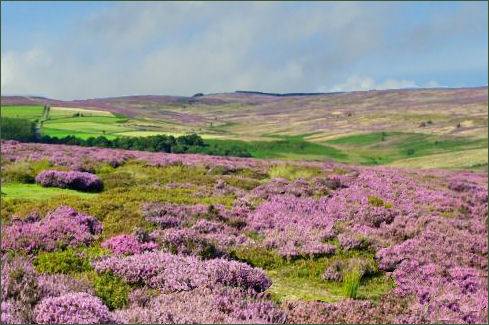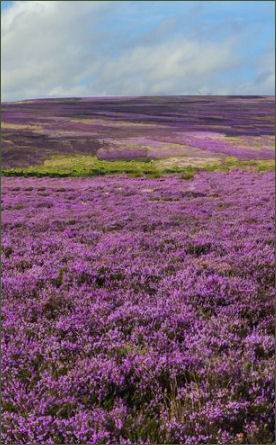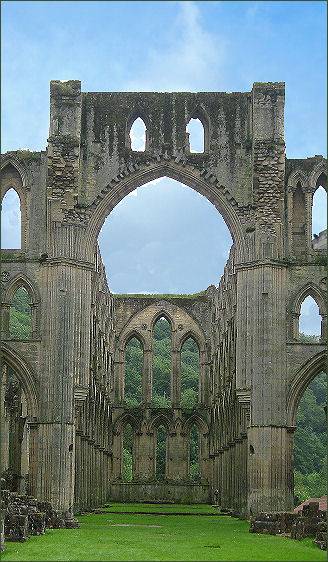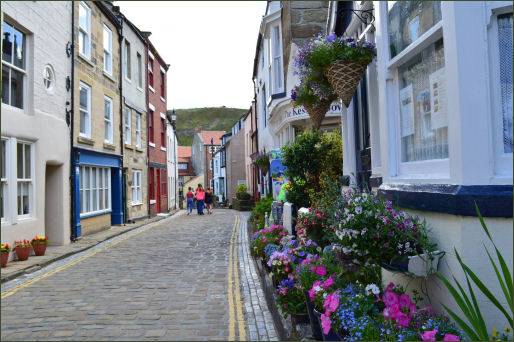The North York Moors National Park
 The beautiful and tranquil North York Moors National Park contains one of the largest expanses of heather moorland in Britain.
The beautiful and tranquil North York Moors National Park contains one of the largest expanses of heather moorland in Britain.
The National Park covers an area of 1,436 square kilometres (554 sqare miles). The North York Moors obtained National Park status in 1952.
The North York Moors lie to the north and east of the historic City of York and stretch over a broad area from the Vale of York and the Vale of Mowbray across to the Yorkshire Coast.
The Vales of York and Mowbray lie to the east of the North York Moors and the market towns of Boroughbridge, Northallerton and Thirsk. Along its western and northern edges lie the Hambleton Hills and the Cleveland Hills. To the east lies the Yorkshire Coast with the popular seaside resorts of Whitby, Scarborough and Filey.
 Popular places to visit in the North York Moors National Park include the characterful village of Hutton-le-Hole, with its picturesque and much photographed village green where sheep still graze. The village is home to the fascinating Ryedale Folk Museum, Yorkshire's leading open air museum, which is set in 5 acres and boasts over 20 historic buildings depicting the lives of ordinary folk from earliest times to the present day. Ryedale itself is a diverse and beautiful area of spectacular scenery, bustling market towns, dale and hill farms, and picturesque villages. Coxwold, one of Yorkshire's most picturesque villages, is located on the southern edge of the North York Moors National Park
Popular places to visit in the North York Moors National Park include the characterful village of Hutton-le-Hole, with its picturesque and much photographed village green where sheep still graze. The village is home to the fascinating Ryedale Folk Museum, Yorkshire's leading open air museum, which is set in 5 acres and boasts over 20 historic buildings depicting the lives of ordinary folk from earliest times to the present day. Ryedale itself is a diverse and beautiful area of spectacular scenery, bustling market towns, dale and hill farms, and picturesque villages. Coxwold, one of Yorkshire's most picturesque villages, is located on the southern edge of the North York Moors National Park
The charming market town of Helmsley is situated 13 miles (21 km) to the west of Pickering at the point where Rye Dale leaves the moorland and joins the Vale of Pickering. Helmsley is an ancient settlement of much character which pre-dates the Norman conquest of 1066, it was referred to in the middle ages as Elmeslac, which means means 'Helm's forest clearing'. The Viking presence in the area is clearly marked in the Old Norse, "gate" ending of the names of many of the town's streets.
 The town boasts a bustling market square, charming tea rooms and inviting inns. The ruins of l Hemsley Castle tower over the town, The castle, which is surrounded by spectacular banks and ditches, is an imposing sight and is shrouded in history and was founded in the early twelfth century by Walter Espec, who also founded nearby Rievaulx Abbey.
The town boasts a bustling market square, charming tea rooms and inviting inns. The ruins of l Hemsley Castle tower over the town, The castle, which is surrounded by spectacular banks and ditches, is an imposing sight and is shrouded in history and was founded in the early twelfth century by Walter Espec, who also founded nearby Rievaulx Abbey.
Medieval Helmsley Castle overlooks the town, the castle was first constructed of timber in around 1120 by Walter l'Espec. The castle was rebuilt in stone in 1186 by Robert de Ros, who built the two main towers, the round corner towers and the main gateway. The de Roos family retained Helmsley Castle until 1478, when it was sold by Edmund de Roos Richard, Duke of Gloucester who was later to became Richard III. After Richard's untimely death at the Battle of Bosworth Field, his successor, King Henry VII restored to Helmesley to Edmund de Roos.
Picturesque Thornton-le-Dale is also well worth a visit. It lies near Pickering on the edge of the North York Moors National Park. A thatched cottage in the village has appeared on numerous calendars and chocolate boxes over the years. The vilage is also famous for its yearly shows where people from the area gather to compete in various events.
Dalby Forest, which covers 8000 acres, is situated on the southern slopes of the National Park and lies 2 miles northeast of Thornton le Dale. The southern part of the forest is divided by a number of valleys creating a 'Rigg and Dale' landscape whilst to the north the forest sits on the upland plateau.
Dramatic Rievaulx Abbey, (pictured left) was founded in 1132 by twelve monks from Clairvaux Abbey as a mission for the colonisation of the north of England and Scotland. The impressive ruins include extensive remains of the church, which was one of the finest in the North, and claustral buildings; five arches from the original cloister also survive. Rievaulx was once one of the richest abbeys in England and was founded in 1132 by twelve monks from Clairvaux Abbey sent by St Bernard of Clairvaux (1090 - 20 August 1153), a French abbot and the primary reformer for the Cistercian order, as a mission for the colonisation of the north of England and Scotland. It was the first Cistercian abbey to be established in the north of England. With time it became one of the great Cistercian abbeys of Yorkshire, second only to Fountains Abbey in fame.
The ruins of Byland Abbey are located in a peaceful setting at New Byland, near Coxwold. The abbey was founded at Calder during the reign of King Henry I by the Savigniac monks of Furness Abbey in Cumbria in 1135. The imposing remains that are still standing include the lower half of a great rose window in the west front, which dates to the thirteenth century.
The town of Whitby faces the North Sea and is set in a deep ravine at the mouth of the River Esk, it is one of North-east Yorkshire's most popular seaside resorts and has much to offer the visitor. Whitby Abbey, founded in Anglo-Saxon times, was made famous by Bram Stoker as a key location in the Dracula tale. The abbey was founded in 651 A.D., by Oswy, king of Northumbria (circa 612 - 15 February 670), a devoted Christian, who promoted the faith among his subjects and establishing a number of monasteries. He had defeated a pagan opponent, Penda, in battle two years prior to founding Whitby Abbey. Oswy appointed Hilda (circa 614-680), the abbess of Hartlepool Abbey, , as its first abbess. Described by the Venerable Bede as a woman of great energy, who was a skilled administrator and teacher, Hilda was also the grand-niece of Edwin the first Christian king of Northumbria.
The small picturesque fishing village of Robin Hood's Bay lies five miles to the south of Whitby. The village is situated at the eastern end of Alfred Wainwright's famous 190-mile Coast to Coast Walk, and is also a popular stopping-off point for those walking the Cleveland Way. Situated about a mile to the south of Robin Hood’s Bay along the ‘Cleveland Way’ Long Distance Footpath, Boggle Hole, is one of the Yorkshire Coast's little known, hidden gems. It consists of a sheltered bay in front of the old converted Watermill, now a youth hostel and was once a notorious smugglers’ haunt. The clifftop path affords stunning views of Robin Hood’s Bay, which sweeps in a graceful curve from the promontory of North Cheek, also called Ness Point, to South Cheek or The Old Peak.
The delightful old fishing village of Runswick Bay on the beautiful Heritage Coast area of the North York Moors boasts much charm.The village is situated 8 miles to the north of the town of Whitby. The village's red-roofed cottages huddle on the northern end of a sweeping bay facing the North Sea. It has a mile long sandy beach and is very popular with holidaymakers. Runswick Bay has a peaceful sandy beach which is sheltered from the northern gales by Lingrow Knowle, the lofty crag which towers above the bay.
 Once one of the largest fishing ports on the North East coast, Staithes, (pictured right) once home to a small fleet of brightly coloured Whitby Cobles, is now largely dependent on tourism to support its economy. The characterful coastal village of narrow winding streets has a sheltered harbour, bounded by high rugged cliffs of Penny Nab, Cowbar Nab, and Bias Scar and has two long breakwaters. Nowadays, the boats are used by local fishermen to catch cod, lobsters and crabs and short pleasure cruises are available. The small beach has a cluster of rock pools. The old town features stone fishermen's cottages and town houses, which huddle around alleys and flights of steps.
Once one of the largest fishing ports on the North East coast, Staithes, (pictured right) once home to a small fleet of brightly coloured Whitby Cobles, is now largely dependent on tourism to support its economy. The characterful coastal village of narrow winding streets has a sheltered harbour, bounded by high rugged cliffs of Penny Nab, Cowbar Nab, and Bias Scar and has two long breakwaters. Nowadays, the boats are used by local fishermen to catch cod, lobsters and crabs and short pleasure cruises are available. The small beach has a cluster of rock pools. The old town features stone fishermen's cottages and town houses, which huddle around alleys and flights of steps.
The picturesque village of Goathland is the setting for the popular television series Heartbeat, the village dates back to Viking times with much of its history still evident. The peaceful moorland village is set around wide grass areas of open common land where black faced sheep graze freely, due to a surving common right from the Duchy of Lancaster which extends back for hundreds of years. Goathland has a history extending back as far back as Viking times. In the early middle ages it was referred to as Godelandia. A charter at nearby Whitby Abbey records that in 1109 King Henry I granted land to Osmund the priest and brethren of the hermitage of Goathland, for the soul of his mother, the Empress Matilda, who had died in 1083.
The small coastal village of Ravenscar is set in a dramatic clifftop location and also lies within the National Park. Ravenscar is situated around 10 miles (16 km) to the north of the popular seaside resort of Scarborough. Ravenscar was the location of a late fourth century Roman signal station, part of a chain of such stations that extended along the Yorkshire coast. Until the early twentieth century the village was known as Peak.
Mount Grace Priory, the ruin of a fourteenth century Carthusian priory is England's most important and best preserved of the ten medieval Carthusian houses (charterhouses) in England. Set in woodland, the priory was founded in 1398 by Thomas Holland, 1st Duke of Surrey, the son of King Richard II's half-brother Thomas, Earl of Kent, it was the last monastery to be established in Yorkshire.
